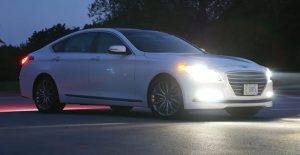Headlights are one of the most critical safety features of any vehicle, allowing drivers to see and be seen during nighttime driving and adverse weather conditions. But beyond brightness and style, what truly defines a headlight’s performance is its beam pattern — the way light is distributed on the road.
Beam patterns balance safety, comfort, and regulatory compliance. Understanding their science can help drivers appreciate why certain technologies are superior, and why proper headlight adjustment is essential.
What Are Beam Patterns?

A beam pattern refers to how light emitted by a headlight is spread across the road and surrounding environment. It is determined by reflector and lens design, bulb technology, and regulatory standards.
Key goals of a proper beam pattern include:
-
Maximizing forward visibility without dazzling oncoming traffic.
-
Illuminating road edges to detect pedestrians, cyclists, or wildlife.
-
Ensuring uniform distribution without dark spots or glare.
-
Adapting to driving conditions such as city, highway, or off-road.
Types of Beam Patterns
There are multiple headlight beam types, each with unique functions and design considerations.
| Beam Type | Purpose | Range & Characteristics |
|---|---|---|
| Low Beam | Everyday driving; avoids glare | Short to medium range, cutoff line angled downward |
| High Beam | Open roads with no traffic | Long range, wide illumination, no cutoff |
| Fog Beam | Foggy or snowy conditions | Wide, low-mounted beam, reduces reflection |
| Adaptive Beam | Adjusts dynamically to conditions | Uses sensors, shutters, or LEDs for variable patterns |
European vs. American Beam Standards
Headlight design is heavily influenced by regional regulations.
| Standard | Key Feature | Effect on Drivers |
|---|---|---|
| ECE (Europe) | Sharp horizontal cutoff to prevent glare | Safer for oncoming traffic, more focused illumination |
| DOT (USA) | Softer cutoff, more upward light allowed | Illuminates overhead signs but can cause glare |
This distinction explains why headlight designs differ between regions, even on the same car model.
The Science Behind Beam Formation
Beam patterns are created by the interaction of three key components:
-
Reflectors – Shape and direct light using parabolic or complex multi-surface geometry.
-
Lenses – Focus or diffuse light, ensuring smooth distribution.
-
Shutters / Shields – In projector headlights, mechanical cutoffs create sharp low-beam patterns.
Modern headlights use advanced optics and precise computer-aided design to optimize every lumen of light.
Headlight Technologies and Their Beam Performance
The type of light source greatly affects beam shape, intensity, and uniformity.
Comparison of Light Sources:
| Technology | Beam Quality | Advantages | Drawbacks |
|---|---|---|---|
| Halogen | Uneven, less sharp | Low cost, easy replacement | Short lifespan, dimmer |
| Xenon (HID) | Strong, long range, sharp cutoff | Bright, efficient, luxury appearance | Can cause glare if misaligned |
| LED | Highly uniform, flexible design | Compact, energy-efficient, customizable | Higher upfront cost |
| Laser | Extremely focused, very long range | High-tech, futuristic look | Expensive, limited use |
Adaptive Beam Systems
Modern vehicles increasingly employ adaptive lighting systems that dynamically adjust beam patterns based on driving conditions.
Features of Adaptive Beams:
-
Automatically dim or shape light to avoid dazzling oncoming cars.
-
Broaden illumination when turning corners.
-
Provide longer reach on highways and shorter, wider beams in city traffic.
-
Detect pedestrians and highlight them with targeted beams.
These systems combine safety and luxury, showcasing how lighting has become central to both performance and brand identity.
Common Issues with Beam Patterns
Even advanced headlights can perform poorly if not maintained or adjusted correctly.
Problems Drivers Encounter:
-
Misalignment – Causes poor visibility or glare for others.
-
Aging lenses – Yellowing reduces beam intensity.
-
Incorrect bulbs – Wrong fitment disrupts the beam pattern.
-
Dirt and debris – Block light output and distort distribution.
Regular maintenance ensures the designed beam pattern functions as intended.
Practical Tips for Drivers

To maximize safety and headlight effectiveness, car owners should follow some best practices.
-
Adjust headlights after suspension changes or heavy loads.
-
Clean lenses and replace cloudy covers.
-
Use OEM-quality bulbs to preserve designed beam patterns.
-
Test alignment periodically, especially before long trips.
-
Upgrade responsibly to LEDs or adaptive systems without bypassing regulations.
Conclusion
Beam patterns are the hidden science behind safe and comfortable driving at night. They embody a delicate balance of physics, optics, and regulation — ensuring drivers see enough of the road without endangering others.
As automotive lighting technology advances, beam patterns are becoming smarter, adapting in real time to traffic and environment. For drivers, this means greater safety, comfort, and even aesthetic appeal.
If you’re considering upgrading or maintaining your lighting system, make sure to explore high-quality options. You can Buy Car Lighting online and find solutions that blend safety, technology, and style.